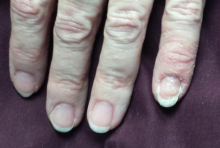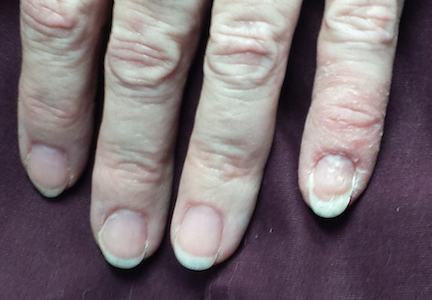User login
A month’s worth of terbinafine 250 mg/d did not improve the appearance of this 47-year-old woman's fifth fingernail and surrounding skin, so she was referred to dermatology. Affecting only this finger, the condition manifested slowly, several months ago, for no apparent reason. Fortunately, few if any symptoms have accompanied the changes—but the patient is quite upset nonetheless.
She denies any antecedent trauma to the finger and says it has not been excessively exposed to wetting and drying. She is otherwise in excellent health. Her only complaint about her health is mild seasonal allergies, along with sensitive skin (which manifested as eczema when she was a child).
EXAMINATION
The skin around the patient's right fifth fingernail is quite dry and scaly. It appears a bit inflamed, and there is visible separation between the cuticle and the adjacent nail plate. The nail itself is abnormal, with a rumpled, dystrophic surface on which transverse ridges are seen. No tenderness is elicited on palpation, nor can any pus be expressed from the subungual area. The rest of her fingernails and her toenails are unaffected.
Continue reading for Joe Monroe's discussion...
DISCUSSION
This problem—chronic paronychia (also known as chronic candidal paronychia)—is not well known outside derm circles. It's even a bit of a mystery within the specialty, although we see it often enough to become comfortable with its diagnosis and treatment.
Here is what we know about it: Separation of the cuticle from the underlying nail plate appears to be the initial insult, with bacteria (candida) and food particles subsequently becoming trapped in the space and provoking an inflammatory response. There is often a history of excessive wetting and drying of the hands. The condition is rarely painful, but initially it can make the area sensitive to touch. The women who present with it—we virtually never see it in men—are usually middle-aged.
Primary care providers confronted with chronic paronychia often prescribe terbinafine for "fungal infection," but this never works because fungi are not involved. Some consider candida to be a type of fungus; however, for practical purposes, it is quite different. It causes completely different disease, is grown on totally different media in the lab, and requires special treatment. Terbinafine, an allylamine, has little if any activity against candida.
It should be noted that in many cases, the infectious component of chronic paronychia is minimal to absent. Therefore, the thrust of treatment is aimed at healing the damaged cuticle and helping it to reattach to the nail plate. This eventually resolves the problem, as the dystrophic nail will grow out and be replaced by healthy, normal-looking nail. Adding an imidazole cream to the treatment regimen will eliminate any suspected organism.
For this patient, I prescribed a month-long course of betamethasone/clotrimazole ointment to be applied twice daily. At follow-up, reconnection of the cuticle to the nail plate was noted, along with complete resolution of the modest redness. The nail was still dystrophic distally but clearing proximally. It should be clear within four to five months.
Continue reading for the take-home learning points...
TAKE-HOME LEARNING POINTS
• Fungal infection is approximately 18 times less likely to occur in fingernails than in toenails, so skepticism is warranted in such cases.
• Atopy probably plays a role in the genesis of chronic paronychia, given the sensitivity of atopic skin to wetting and drying.
• The primary goal of treatment in these cases is to encourage reattachment of the cuticle to the nail plate.
• Oral terbinafine is ineffective against candida and should only be used in cases of proven or strongly suspected fungal infection.
• Chronic candidal paronychia can affect one or more fingernails but is almost never seen in toenails.
A month’s worth of terbinafine 250 mg/d did not improve the appearance of this 47-year-old woman's fifth fingernail and surrounding skin, so she was referred to dermatology. Affecting only this finger, the condition manifested slowly, several months ago, for no apparent reason. Fortunately, few if any symptoms have accompanied the changes—but the patient is quite upset nonetheless.
She denies any antecedent trauma to the finger and says it has not been excessively exposed to wetting and drying. She is otherwise in excellent health. Her only complaint about her health is mild seasonal allergies, along with sensitive skin (which manifested as eczema when she was a child).
EXAMINATION
The skin around the patient's right fifth fingernail is quite dry and scaly. It appears a bit inflamed, and there is visible separation between the cuticle and the adjacent nail plate. The nail itself is abnormal, with a rumpled, dystrophic surface on which transverse ridges are seen. No tenderness is elicited on palpation, nor can any pus be expressed from the subungual area. The rest of her fingernails and her toenails are unaffected.
Continue reading for Joe Monroe's discussion...
DISCUSSION
This problem—chronic paronychia (also known as chronic candidal paronychia)—is not well known outside derm circles. It's even a bit of a mystery within the specialty, although we see it often enough to become comfortable with its diagnosis and treatment.
Here is what we know about it: Separation of the cuticle from the underlying nail plate appears to be the initial insult, with bacteria (candida) and food particles subsequently becoming trapped in the space and provoking an inflammatory response. There is often a history of excessive wetting and drying of the hands. The condition is rarely painful, but initially it can make the area sensitive to touch. The women who present with it—we virtually never see it in men—are usually middle-aged.
Primary care providers confronted with chronic paronychia often prescribe terbinafine for "fungal infection," but this never works because fungi are not involved. Some consider candida to be a type of fungus; however, for practical purposes, it is quite different. It causes completely different disease, is grown on totally different media in the lab, and requires special treatment. Terbinafine, an allylamine, has little if any activity against candida.
It should be noted that in many cases, the infectious component of chronic paronychia is minimal to absent. Therefore, the thrust of treatment is aimed at healing the damaged cuticle and helping it to reattach to the nail plate. This eventually resolves the problem, as the dystrophic nail will grow out and be replaced by healthy, normal-looking nail. Adding an imidazole cream to the treatment regimen will eliminate any suspected organism.
For this patient, I prescribed a month-long course of betamethasone/clotrimazole ointment to be applied twice daily. At follow-up, reconnection of the cuticle to the nail plate was noted, along with complete resolution of the modest redness. The nail was still dystrophic distally but clearing proximally. It should be clear within four to five months.
Continue reading for the take-home learning points...
TAKE-HOME LEARNING POINTS
• Fungal infection is approximately 18 times less likely to occur in fingernails than in toenails, so skepticism is warranted in such cases.
• Atopy probably plays a role in the genesis of chronic paronychia, given the sensitivity of atopic skin to wetting and drying.
• The primary goal of treatment in these cases is to encourage reattachment of the cuticle to the nail plate.
• Oral terbinafine is ineffective against candida and should only be used in cases of proven or strongly suspected fungal infection.
• Chronic candidal paronychia can affect one or more fingernails but is almost never seen in toenails.
A month’s worth of terbinafine 250 mg/d did not improve the appearance of this 47-year-old woman's fifth fingernail and surrounding skin, so she was referred to dermatology. Affecting only this finger, the condition manifested slowly, several months ago, for no apparent reason. Fortunately, few if any symptoms have accompanied the changes—but the patient is quite upset nonetheless.
She denies any antecedent trauma to the finger and says it has not been excessively exposed to wetting and drying. She is otherwise in excellent health. Her only complaint about her health is mild seasonal allergies, along with sensitive skin (which manifested as eczema when she was a child).
EXAMINATION
The skin around the patient's right fifth fingernail is quite dry and scaly. It appears a bit inflamed, and there is visible separation between the cuticle and the adjacent nail plate. The nail itself is abnormal, with a rumpled, dystrophic surface on which transverse ridges are seen. No tenderness is elicited on palpation, nor can any pus be expressed from the subungual area. The rest of her fingernails and her toenails are unaffected.
Continue reading for Joe Monroe's discussion...
DISCUSSION
This problem—chronic paronychia (also known as chronic candidal paronychia)—is not well known outside derm circles. It's even a bit of a mystery within the specialty, although we see it often enough to become comfortable with its diagnosis and treatment.
Here is what we know about it: Separation of the cuticle from the underlying nail plate appears to be the initial insult, with bacteria (candida) and food particles subsequently becoming trapped in the space and provoking an inflammatory response. There is often a history of excessive wetting and drying of the hands. The condition is rarely painful, but initially it can make the area sensitive to touch. The women who present with it—we virtually never see it in men—are usually middle-aged.
Primary care providers confronted with chronic paronychia often prescribe terbinafine for "fungal infection," but this never works because fungi are not involved. Some consider candida to be a type of fungus; however, for practical purposes, it is quite different. It causes completely different disease, is grown on totally different media in the lab, and requires special treatment. Terbinafine, an allylamine, has little if any activity against candida.
It should be noted that in many cases, the infectious component of chronic paronychia is minimal to absent. Therefore, the thrust of treatment is aimed at healing the damaged cuticle and helping it to reattach to the nail plate. This eventually resolves the problem, as the dystrophic nail will grow out and be replaced by healthy, normal-looking nail. Adding an imidazole cream to the treatment regimen will eliminate any suspected organism.
For this patient, I prescribed a month-long course of betamethasone/clotrimazole ointment to be applied twice daily. At follow-up, reconnection of the cuticle to the nail plate was noted, along with complete resolution of the modest redness. The nail was still dystrophic distally but clearing proximally. It should be clear within four to five months.
Continue reading for the take-home learning points...
TAKE-HOME LEARNING POINTS
• Fungal infection is approximately 18 times less likely to occur in fingernails than in toenails, so skepticism is warranted in such cases.
• Atopy probably plays a role in the genesis of chronic paronychia, given the sensitivity of atopic skin to wetting and drying.
• The primary goal of treatment in these cases is to encourage reattachment of the cuticle to the nail plate.
• Oral terbinafine is ineffective against candida and should only be used in cases of proven or strongly suspected fungal infection.
• Chronic candidal paronychia can affect one or more fingernails but is almost never seen in toenails.

